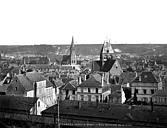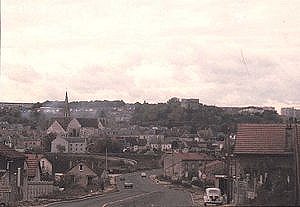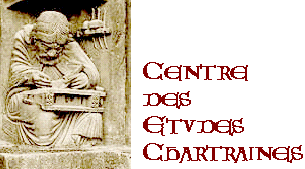
![]()
This
Site is Sponsored By : Christopher's
Book Room
(specializing in Books on the Middle Ages)
And is Hosted by the remarkable Ariadne's Thread.
Nota Bene: The new material herein is under Copyright.]
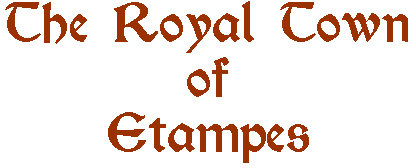
|
A circa
1900 photograph taken from somewhere on the hill of the Tour Guinette,
looking West over the roof of the train station, with the parish church
of St. Basile under the squat tower in the right
foregeround and the collegial church of St. Mary under its 13th century
spire on the left.
|
|
| The Royal Collegial
Abbey of St. Mary is the large church with its flat chevet visible under
the spire to the left. The smaller, squat tower of the parish church of St. Basile is barely visible just to its right. The remains of Louis VI's tower is on the horizon, just to the right of center. The "suburb" of St. Martin is off the picture, to the left. My 1958 "Four Horses" Renault 4cv is in the right foreground. |
|
|
The
town of Étampes, which, until recent decades (when the R.E.R.
line from central Paris was completed, transforming it into a bedroom
suburb of Paris) was something of a backwater, enjoyed an extraordinary
essor during a short period, early in the history of the Capetian
dynasty (between the early 11th and later 12th centuries). Although
it remained an important fief of the Crown in subsequent centuries,
the town never really regained its prominence, which was based upon
its supreme strategic position in these years. -------------------------- (2) Robert-Henri Bautier, ed., Helgaud de Fleury, Vie de Robert le Pieux, Epitoma Vitae Regis Rotberti Pii. (Paris: CNRS, 1965), p. 64 : "Stampis castro, regina Constantia palatium construxerat nobile simul cum oratario; quo delectatus rex ad prandendum cum suis l[a]ectus assedi.." Bautier notes (p.64, note 1, citing M. Prou, "Une ville-marché au XIIe sièecle, Étampes", Mélanges d'histoire offerts à H. Pirenne, p. 4) that this "palatio" was located "between the rue de la Juiverie and those of la Roche-Plate and la Vigne," ; that it was destroyed during the reign of Henry IV ; and that Queen Constance, daughter of Count William of Provence and Alix of Anjou, married Robert between 1001 and 1003 and died at Melun in July, 1032. This "oratorio" was, apparently, the parish church of St. Basile (see below, note 4). (3)
Ibid., p. 130 : "Fecit...monasterium sanctae Mariae,
in Stampensi castro; item in ipso castor, aecclesiam unam in palatio..."
Note 9 : "The donations made by Robert to the canons of Notre-Dame
of Étampes are known by a 1046 act of King Henry I (Soehnée,
no. 73, p. 76 and, following him, Newman, no. 99, p. 124). If we can
believe the canons, the church was built in 1022 (arrêt du
parlement, 23 January, 1572, cited by J.-M. Alliot, ed., Cartulaire
de Notre-Dame d'Étampes, 1888, p. 145). (4)
"Fecit [rex]...monasterium sanctae Mariae,
in Stampensi castro; item in ipso castro, aecclesiam unam in palatio..."
(Bautier, Ibid., p. 131, with this interpretation at p.
131, n. 10 : "This church would be the present parish church of
St. Basil, which first appears by name in the confirmation charter of
1046 by Henry I [Alliot, Ibid., p. xv].") |
|
Please note
that this Site is
![]()
And
is maintained by
Christopher Crockett
(who absolutely cannot be held
responsible if the above condition is not
rigorously adhered to).
Your input, comments and even (mild, gentle)
criticisms
are welcome and solicited.
Write me at:
bccrockett@usa.net
And
with special thanks to Susan R. Dixon,
Creatrice of

Specializing in :
Web Designing
with the goal of enabling organizations
to transform the way they create and interact with the world.
And sponsor of Medieval
WebArtists, a cooperative project
providing server space for those working with any body of
scholarship about medieval art, history, literature, or life
that they wish to put on the web, an Ideal Home for Scholars
who have no academic affiliation and therefore little access
to stable accomodations for their work.

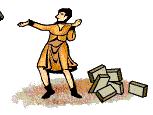
(wait 7 seconds)


© NOTICE:
The contents of this page (errors and all) are Copyright
© Christopher Crockett, 2002. Any commercial-free use for educational
purposes
is hereby authorized, though I would appreciate hearing of the use to
which my work
is being put (please write me informing me of such:: bccrockett@usa.net
).
The right to Any commercial use (uncluding publication in any
vehicle which is sold)
is dependant upon Explicit, Written Permission, obtainable
from the above
Vintage photographs courtesy of the "Base de Données Mémoire, ministère de la Culture et de la Communication - direction de l'Architecture et du Patrimoine".
